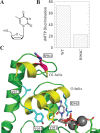R964C mutation of DNA polymerase gamma imparts increased stavudine toxicity by decreasing nucleoside analog discrimination and impairing polymerase activity
- PMID: 19364868
- PMCID: PMC2687208
- DOI: 10.1128/AAC.01659-08
R964C mutation of DNA polymerase gamma imparts increased stavudine toxicity by decreasing nucleoside analog discrimination and impairing polymerase activity
Abstract
The R964C mutation of human DNA polymerase gamma was recently linked to stavudine (d4T)-mediated mitochondrial toxicity. We utilized pre-steady-state kinetics to determine the effect of this mutation on incorporation of natural substrate dTTP and the active metabolite of d4T (d4TTP). The R964C polymerase gamma holoenzyme demonstrated a 33% decrease in dTTP incorporation efficiency and a threefold-lower d4TTP discrimination relative to that of the wild-type polymerase gamma, providing a mechanistic basis for genetic predisposition to nucleoside reverse transcriptase inhibitor toxicity.
Figures

References
-
- Astatke, M., N. D. Grindley, and C. M. Joyce. 1998. How E. coli DNA polymerase I (Klenow fragment) distinguishes between deoxy- and dideoxynucleotides. J. Mol. Biol. 278:147-165. - PubMed
-
- Brinkman, K., and T. N. Kakuda. 2000. Mitochondrial toxicity of nucleoside analogue reverse transcriptase inhibitors: a looming obstacle for long-term antiretroviral therapy? Curr. Opin. Infect. Dis. 13:5-11. - PubMed
-
- Chiappini, F., E. Teicher, R. Saffroy, B. Debuire, D. Vittecoq, and A. Lemoine. 2009. Relationship between polymerase gamma (POLG) polymorphisms and antiretroviral therapy-induced lipodystrophy in HIV-1 infected patients: a case-control study. Curr. HIV Res. 7:244-253. - PubMed
-
- Feng, J. Y., A. A. Johnson, K. A. Johnson, and K. S. Anderson. 2001. Insights into the molecular mechanism of mitochondrial toxicity by AIDS drugs. J. Biol. Chem. 276:23832-23837. - PubMed
Publication types
MeSH terms
Substances
Grants and funding
LinkOut - more resources
Full Text Sources
Medical

